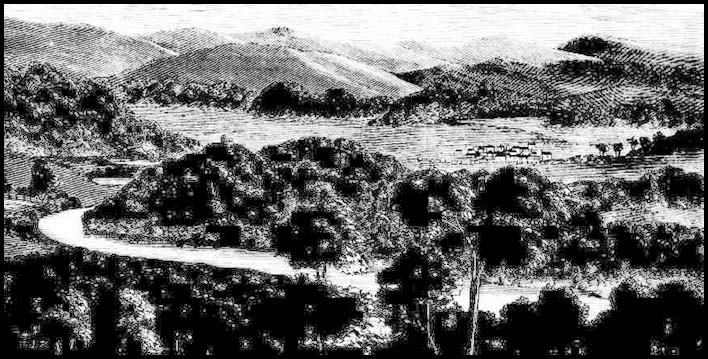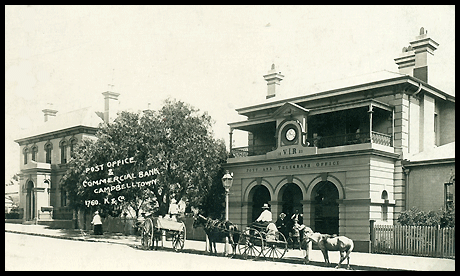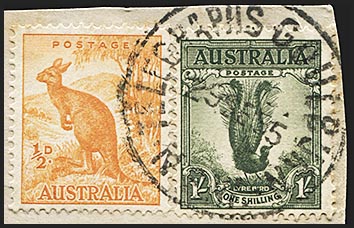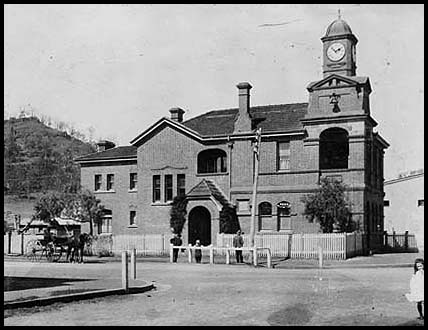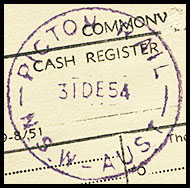Offices on the Southern line to the Victorian border.
- Australia 1901-1988
- New South Wales
- Overview of NSW
- Telegraph lines
- Telegraph Offices
- Date stamps
- Forms
- Envelopes
- Instructional annotation
- Collect
- Delayed
- Free
- Immediate Urgent
- Reply paid
- Rates
- Stamps
- 1871 Telegraph stamps
- 1885 proposal
- 1893 proposal
- Queensland
- South Australia
- Tasmania
- Victoria
- Western Australia
- International
- Special aspects
The Post & Telegraph Offices on the first NSW to Victoria line are listed in the table below:
| Albury | Berrima | Campbelltown | Germantown | Goulburn | Gundagai |
| Holbrook | Liverpool | Picton | Parramatta | Redfern | Yass |
The Telegraph Offices on the first line in New South Wales constructed to the south were important staging centres on the main "Port Phillip Road" to Melbourne from Sydney. The stage coaches were constantly carrying general supplies, people and mail between these centres.
In addition to Albury being an important station along the twice weekly stage-coach run linking Yass and Gundagai via Albury to Melbourne, Albury was also linked from 1860 to Deniliquin via Cowra. The Albury Post Office opened on 1 April 1843. The Post and Telegraph Offices were merged on 1 October 1883 with Clarinda Rowe appointed as the Post Mistress. |
|
2. The Private line and Telegraph Office. The Albury initiative to build their own telegraph line is described elsewhere. The people also opened their own Telegraph Office:
On 4 May 1858, an "experiment" to demonstrate the effective use of the telegraph was conducted at (privately operated) Albury Telegraph Station. It showed the effective use of the telegraph to support commercial operations. Details are to be found in two Sydney Morning Herald articles - Part 1 and Part 2.
3. The Government Telegraph line. The Sydney Morning Herald of 26 March 1858 published:
"On the 9th April 1858, the towns of Albury and Melbourne were placed in telegraphic communication, the inhabitants of Albury having themselves erected the connecting line and the Government having dispatched thither an operating clerk with the necessary instruments and batteries, etc". |
|
At noon on the 28th October, 1858 the Sydney wire was brought into the Albury station. At 3 p.m. on the following day, telegraphic communication was established between the three colonies of Victoria, South Australia and New South Wales. The line was immediately opened by the Government for business. Many newspapers including the Geelong Advertiser were however soon to report "a heavy thunderstorm from the southward struck on 24 January 1859. The lightning entered the telegraph office (at Albury), struck the corner of the relay, fusing the wire and slightly stunning the line inspector who was near. The report was like a pistol going off. The communication by telegraph was interrupted both ways from here. The floods washed away a quarter of a mile of posts on the Melbourne line, and damaged the Sydney side between Gundagai and Albury. No communication with Melbourne since Monday morning and Sydney Monday night, till this morning (Thursday)". The Maitland Mercury of 25 January 1859 reported the storm as follows: "Violent thunderstorms which occurred last week between the Ovens and Gundagai did great damage to the telegraph line. The posts for a quarter of a mile in length were swept away by the violence of the floods on the other side of Albury. During the storm on Monday last, one of the line inspectors, whilst standing in the Albury station, were completely stunned by a shock from the electricity playing upon the wires. The telegraph clerk also received injuries. As the storm passed along, it committed its ravages on Monday at Albury, on Tuesday between Albury and Gundagai, and on Wednesday between Gundagai and Yass". Advent of the telephone. The telegraph staff across all Colonies were generally an inventive mob and keen to try new things. Hence, according to the Albury Banner of 30 March 1878, "A very interesting series of experiments have been made with the telephone by Mr. C. A. Middleton, our local telegraph master, in conjunction with Mr. McGaurin, of Albury. It has been expected for some time back that a message uttered in Albury could be distinctly heard in Wagga Wagga and vice versa, and last week this result was achieved. The distance from here to Albury by wire is about 125 miles and, we are informed, that is the greatest distance that has been spanned by vibration of the telephone".
4. The Government Telegraph Office - a Never-Ending Story. The Sydney Morning Herald of 26 March 1858 published:
It was the season for making decisions: On 20 April 1858, the Herald continued reporting "The building for the Bank of New South Wales is nearly completed, and the place where they have carried on business (late the old court-house) is, we are informed, to be occupied as the Electric Telegraph Office". A mere six months after the connection between Albury and Melbourne, the NSW Government opened the second Albury Electric Telegraph office in the building where the Bank of New South Wales had carried on business (later the building was to become the court-house). "Although the line worked well, the amount of business that at once ensued on the line being opened, together with the comparative inexperience of the operators (all of whom with one exception were young hands trained in the Sydney office and not accustomed to the sole charge of stations) caused some delays in the transmission of messages in 1858. Since April 1859, when some departmental changes were made, the working of the line has been excellent". One presumes the six month delay was insufficient to have a Human Resources training program implemented in other offices along the line. But after all - the Albury office is a long way from Sydney and - out of sight .... "In addition, I regret to state, however, that upon the two last occasions of the arrival of the mail from England the Press messages have not been received at Albury and that therefore although the arrangements made by this department for that purpose remained perfect, the messages could not of course be furnished. The inconvenience to the public and the loss of revenue have been so great, as to render the matter worthy of the special attention of the Government". In 1860, newspapers were reporting stories such as: "Complaints are made that the Albury Telegraph Office affords miserable accommodation both to the operators and the public. The Border Post says that so glaring has the inconvenience become that the municipal authorities have taken the matter up and a motion had. been placed on the notice paper with the view of intimating to the Government the general unfitness of the building for the purposes to which it had been applied; and the public also were getting up a memorial on the same subject". The Chief Secretary was quick to reply to a question from Mr. Asher - in the Assembly of 25 January 1860 - "that no time would be lost in erecting a suitable Telegraph Office at Albury". The Gazette of 30 March 1860 advertised for tenders for "the erection of an Electric Telegraph Station at Albury - closing at 12 o'clock noon Tuesday 8th May". This advertisement did not attract an acceptable tenderer - hence a new building was frequently sought. In the Legislative Assembly of 4 June 1860, the Secretary for Public Works was asked "does the Government intend calling for fresh tenders for a Telegraph Office at Albury or do they intend continuing conducting that branch of business in the wooden box at present called a Telegraph Office?". The above advertisement was repeated in the Gazette of 13 July 1860. A tender was accepted on 11 August. The ceremony for laying the corner stone for a new office was held on 5 November 1860 - the authorities always being in a rush to get things done. The Albury Banner of 5 October 1861 reported on an interchange in the Legislative Assembly: "We stated some time back that there was some probability of these offices in Albury being amalgamated under one roof. From a question put to Mr. Weekes in the Legislative Assembly on Friday last, we see no reason to doubt this will eventually be accomplished. The new Electric Telegraph Office is unquestionably too small to afford room for the purpose, yet we suppose, if there be only the will" on the part of the Government, the Colonial Architect will make the "way" — though perhaps Mr. Kraegen may be temporarily inconvenienced thereby, or not, as the case may be. The question to which we refer and answer will be found in the Parliamentary intelligence. We don't like the expression "When circumstances enable them to do so" — we should like something more definite as to time certainly; but still, notwithstanding the room for delay apparent in this india rubber sentence, we do hope this event, so much desired by the influential public of Albury, will be brought about as speedily as possible. We may also call attention to the debate which took place consequent on the motion of Mr. Dangar, to show that the aversion to having post-offices connected either with stores or public houses is not peculiar to this place alone". 4.1: A time ball at the Telegraph Office. The Albury Banner of 6 December 1862 described the possible role of the Telegraph Office (and Mr. Kraegen) - presumably in the old Bank of NSW building - in assisting the Albury-ites to be aware of the real time: "This is a question frequently put in Albury, and is much more often made than answered. If one can get within a quarter or so of the real hour, every body is contented, but between Sydney time and Melbourne time or, as we are now, no time at all, it is a difficult matter really to answer the enquiry of "what's o'clock"? Until lately, by the kindness and, we believe at the cost of the Telegraph Station Master, Mr. Kraegen, Albury rejoiced in the possession of a time-ball which was dropped when cords etc. allowed, an hour after noon, and great was the watching for the diurnal event. Now, as the tackle is out of order, we are again timeless. Not a public clock of any kind exists while those of the several hostelries only "agree to differ". Some talk is made of re-arranging the time ball by means of a public subscription, but while we are about it, we would suggest that it would be better to have a gun fired at a certain hour at the Telegraph Office, which could be heard for a mile or so around and which would fall upon the ear when we might forget to look out for the dropping of the ball. The cost would be but trifling and we think it would be an improvement on the old method. However, whether we are to have a notion given to us in future of the time of day by gun or ball a trifling subscription on the part of the townsfolk will be necessary and we are sure, for so useful an end, that every tradesman will at once take his half crown to Mr. Kraegen at the Telegraph Office". Almost immediately after, the Albury Municipal Council met on 5 October 1864 (according to the Albury Banner of 8 October). Correspondence was received "from Mr. Charles Kraegen, Station-Master, Telegraph Station, Albury, representing that some time since, at the suggestion of several inhabitants, some action was taken to erect a time-ball for the use of the town, and that he guaranteed personally the sum of £30 to Mr. Owen for the same. But it being found that the height of the flag-staff was not sufficient for general purposes, an additional mast was erected. The total cost claimed by Mr. Owen is now some £47 of which £22 has been paid and that, after paying the sum of £8 to make up the £30, a balance of £17 would be remaining and asking for a vote from the Council funds in reference thereto". Alderman Jones immediately took decisive action and moved that the letter be referred to the Public Works Committee. At the 26 October meeting of the Council, the reports of the Public Works Committee and the Finance Committee were adopted and Alderman Jones moved that "£30 be paid (out of Municipal funds) to Mr. Charles Kraegen to reimburse that gentleman for his expenditure in the erection of a time-ball". At the Council meeting on 2 November "the Aldermen recommended that the sum of £8 be voted by the Council towards the cost of the erection of the Time Ball at the Telegraph Office, and that a vote of thanks be given to Mr. Kraegen for working the same gratuitously for the public benefit". Further discussions as to payments continued at the meetings of 21 June 1865 and 5 July 1865. |
|
| Albury Post Office in 1863. (no time ball to be seen) The sign behind the tree at the top left is "POST & TELEGRAPH OFFICE". Source NLA C4078 N20516. |
 |
It is a little hazy about what happened over the next few years BUT:
In August 1896, the Albury Banner reported that an investigation was underway to determine the advisability of combining the Post and Telegraph offices at Albury within the context of Civil Service reductions. The amalgamation took place on 2 June 1904. Many other amalgamations had taken place since 1870. |
|
The building shown in these two scans was built in the Victorian Classical style. It appears to have been a renovation of the 1863 building. The opening was celebrated on 19 January 1880. |
 |
| 5. Personnel:
In 1858, a small boy, 13 years of age, was employed as a messenger in the telegraph office at Wodonga in Victoria. He received as a remuneration of thirty shillings per week, and sixpence per mile for all messages conveyed by his hands. His earnings amounted to about £3 weekly. Across in NSW, the Albury Postmaster, who filled a responsible office and was burdened with the performance of heavy duties, receives the paltry pittance of £1 18s. 6d. weekly.
The Maitland Mercury of 4 May 1875 gave the following acknowledgement:
|
|
|
The earliest indications of the operation of the Albury Telegraph Office are:
|
|
|
Albury was one of the 29 Telegraph Offices included in the special printings of delivery envelope NC-EO-3 made in 1858. These envelopes incorporated an embossed oval seal (like that on EO6-ET) on the flap of the envelope with NEW SOUTH WALES at the top and ELECTRIC TELEGRAPH at the base. The office name was embossed across the centre of the seal.
|
 Scan of embossed oval on flap of envelope. Provenance: De La Rue Archives, Gundersen, Johnstone Collection. |
|
Two types of date stamp were issued to Albury for use with telegraphs: |
||
|
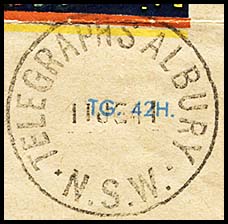 11 June 1941. Used on AB-GBF-39A. |
 17 April 1953. Used on AW-DO-10B (49). |
|
 31 August 1959. Used on AA-DO-13B. |
|
| The only TELEGRAPH slogan cancellation recorded as having been used at Albury of the ten slogans made available throughout Australia is SEND A TELEGRAM.
|
 28 July 1938. |
Telegraph Offices were also opened at:
|
|
|
Tenders were called in the Gazette of 13 July 1860 for the erection of an Electric Telegraph Station at Berrima with a closing date of 24 July. It was however decided subsequently that an existing building in the town would be purchased. The Telegraph Office opened on 6 September 1858 - about five months after the line had been connected. Given that date, the delay must have been occasioned by the lack of instruments - which appear to have arrived for Redfern, Parramatta, etc during September. The Yass Courier of 8 February 1862 reported "On Thursday last, while a heavy thunder storm was raging over the telegraph line below Goulburn, Mr. Mackel, the station-master and line inspector at Berrima, received a shock from the electric fluid while despatching a message. We learn he was knocked senseless for some time, and on recovering it was found that he had lost the use of one of his legs. It is to be hoped that the injury received will be subdued under medical treatment". |
Campbelltown was one of the 29 Telegraph Offices included in the special printings of delivery envelope NC-EO-3. These envelopes incorporated an embossed oval seal (EO6-ET) on the flap of the envelope with NEW SOUTH WALES at the top and ELECTRIC TELEGRAPH at the base. The office name was embossed across the centre of the seal.
|
 Scan of embossed oval on flap of envelope. Provenance: De La Rue Archives, Gundersen, Johnstone. |
|
A Telegraph Office with the name Germanton was opened in 1858. A Post Office opened in 1857 and the combined Post & Telegraph Office opened as Ten Mile Creek on 13 January 1873. Tenders called for the "Erection of a Court House and a Telegraph Station at Ten Mile Creek" closed on 28 October 1873. On 1 May 1875, the name Ten Mile Creek was changed to Germanton and officially gazetted the following year. Then another change of name to Holbrook was effected on 20 September 1915. Through the influence of the World War, Germanton was deemed to be unpatriotic by many people.
There are only three known post marks for Germanton - including the only one know recorded on a telegram form:
|
| Goulburn
The Goulburn Telegraph Office was opened on 17 May 1858. It was not until 24 January 1901 that the Post and Telegraph offices merged. The Goulburn Post Office had opened on 1 February 1832. See elsewhere for detais of line construction to Goulburn. |
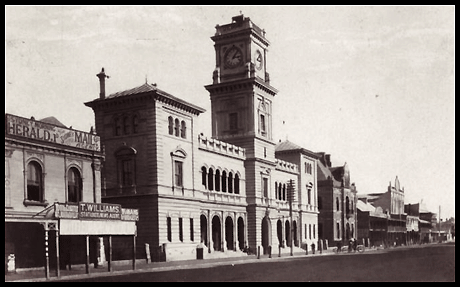 |
|
Construction of the Telegraph Office. The Goulburn Chronicle (28 April 1858) noted: "A few days will now see Goulburn united with Sydney by the magic tie of the electric wire. The poles have been erected for some distance beyond this town and the wire has passed Wingello and will, it is expected, be completed to Goulburn by Monday next. It is in contemplation, we understand, to erect the Telegraph Station in Sloane Street, on the Recreation Ground opposite the Court House. In the first instance however, the instruments will be put to work in some temporary place of accommodation. We trust the authorities will lose no time, after the wire has reached us, making the advantages of the telegraph practically available". The Goulburn Herald of 19 May described the opening of the telegraph line as follows: "The important work of telegraphic communication between Goulburn and Sydney having been completed, the line was opened for the use of the public on Monday last. Through the courtesy of Mr. Cracknell, the Superintendent, and of Mr. Makel, the resident operator, the inhabitants were allowed fully to inspect the process. In the course of the day twenty one messages were transmitted and twelve replies received. The first message was sent by Mr. R. Craig and his reply was also the first received. The second reply was to a private message sent to a friend by the Editor of this journal. At present the temporary office is at Mr. J. J. Roberts's, Goulburn Hotel but it is in contemplation to erect permanent offices on the ground in Montague Street, adjoining the site of the proposed Hall of the Goulburn School of Arts". The Goulburn Herald of 31 July 1858 updated its readers with the latest news: "The site of the gaol reserve, between the gaol and School of Arts, now in course of erection, has been recommended by the local authorities as the most eligible spotNo comment necessary. for the erection of the electric telegraph office". Eighteen years later, in 1876, the Telegraph Office was still located in Montage Street. This story of the Goulburn Telegraph Office, Post Office and other important Government buildings continues elsewhere. Personnel. The Gazette of:
|
||
Three types of date stamps were issued to Goulburn for use with telegraph work:
|
 28 July 1932. |
 3 March 1939.
|
|
||
|
 10 April 1981. Used on an official Australia Post envelope. |
|
|
 23 January 1950. Used on AW-DO-10BB (48). |
|
|
 13 August 1980. |
|
| Gundagai
Gundagai was an important place in the early Colonial days because of its strategic location on the "Port Phillip Road". The Gundagai Post Office had opened on 1 April 1843. A newer building was opened in 1880 and it was later remodelled further. See elsewhere for details of line construction to Gundagai. The Gundagai Telegraph Office opened on 28 August 1858. It merged with the Post Office on 1 January 1870. Tenders were called in the Gazette of 13 July 1860 for the erection of an Electric Telegraph Station at Gundagai with a closing date of 24 July. |
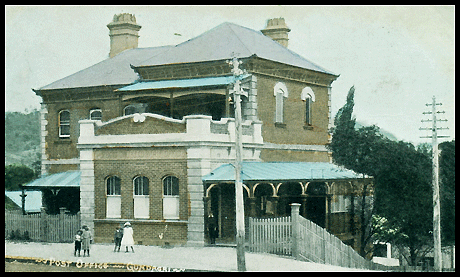 The building shown above was opened in 1880. It was later remodelled. |
|
||||||
|
A Post Office was opened at Gunning on 1 October 1840. It closed on 30 June 1854. A Telegraph Office was opened on 17 March 1875 - a long time after the Southern line had been constructed. Gunning is located about half way between Goulburn and Yass. The Office was upgraded to a Post & Telegraph Office on 15 June 1882. |
|
A Telegraph Office was opened at Tarcutta on 10 August 1875. The Riverine Grazier of 15 October 1879 noted that "The telegraph office at Tarcutta was burglariously entered on Friday night. The instruments were damaged and a small sum of money taken". |
| Yass.
The line to Yass was opened on 25 August 1858. It is probable that the office used was in the local court-house. Barely a moment in time passed (all things are relative) before the new Telegraph Office was opened - on or about 24 June 1865 - 7 years being nothing in the overall history of time. The Yass Courier of that date noted: "Our new Telegraph Office is at last occupied. The Government must have desired that the station master and his assistant should be preserved from danger in entering a new-built, unaired house. We heartily wish them all peace and harmony therein". |
 The Yass Post and Telegraph Office building is on the right in the above photograph. It was opened in 1884. The clock tower and turret were added in 1888. |
||
It merged with the Post Office on 17 October 1884. The Yass Post Office had opened on 1 April 1835. It is one of the most historic post offices in NSW. It was from Yass that the first overland communications with Port Phillip were established. |
|||
On 28 August 1858, the Yass Courier happily reported:
On Friday 29 September 1858, the telegraph line from Sydney via Yass to Albury and Melbourne was opened to traffic. The Telegraph Department claimed that the additional load adjusted the intermediate stations causing delays. The Yass Courier adjusted that explanation to delays being caused by "gross negligence, or as our correspondent supposes, unfair partiality" as message from customers other than the Courier did pass through the line to Sydney. On 14 October 1859, the Sydney Morning Herald carried the following Government Notice: "Whereas it has been represented to the Government that on the night of the 8th Instant the Electric Telegraph Office at Yass was broken into by some person or persons unknown. Notice is hereby given, that a reward of £10 will be paid by the Government to any person who may, within six months from the present date, give such information as shall lead to the apprehension and conviction of the guilty parties". The Yass Courier reported on 24 March 1860 that "We have seen the plans of the premises intended to be erected for the Telegraph office at Yass. The design is a very handsome one and will provide for two bedrooms, parlour, kitchen and suitable office. The outbuildings will consist of a stable, battery, store-room, etc. The cost of erection will probably be upwards of £1,600". Tenders were called in the Gazette of 13 July 1860 for the erection of an Electric Telegraph Station at Yass with a closing date of 24 July. The tender submitted by Mr. W. H. Downey was accepted on 5 September 1860. On 10 October, the Yass Courier reported progress: "A few days since, the contractor for the new Telegraph Office, Mr. W. H. Downey, commenced operations for the structure. The site selected by the Government is at the north angle of the Court House reserve, and faces Cooma Street". The Sydney Morning Herald of 22 October 1860 expanded on this announcement: "Several new telegraph stations are in progress or about to be proceeded with, the courthouses having hitherto been used for that purpose in the towns through which the wires have been carried. New stations have been commenced at West Maitland, Newcastle, Windsor, Albury, Goulburn, Bathurst, and Yass and others will soon be put up at Gundagai, Hartley and Wollombi. The buildings are nearly all upon one plan consisting of five rooms including a residence for the station master". A Telegraph Line inspector needed to be constantly aware of problems which affected his lines. The Yass Courier of 3 April 1861, for example, reported "The line inspector at Yass has requested us to state that, on several occasions lately, the telegraph wires, where they cross Rossi Street, have been twisted and he believes that draymen passing across the new bridge inadvertently throw the lash of their whips over the wires, causing the interruption in the circuit alluded to. It is to be hoped that more care will be taken by these persons for the future". On 14 November 1862, a storm developed over Yass. "Peals of thunder and flashes of lightning then followed but it was some little time before the rain began. But when it commenced, it came down in such generous quantities as soon to make the gutters run. During the storm the lightning entered the telegraph office, while the operator and line-inspector were fixing a relay. The shock was very great and both Mr. Wilson and Mr. Buckley had a narrow escape of their lives. Some slight damage was done but we are informed it was easily repaired" (Yass Courier). A similar problem was encountered in 1868. The Sydney Morning Herald of 21 January reported: "... The lightning entered the telegraph office in the afternoon and three relays were destroyed, although all the usual precautions had been taken to prevent such calamity. The line-inspector's horse while standing in the stable at the rear of the main building was knocked down and some of the hair on its rump singed, it is supposed by the close proximity of the lightning ... Communication by telegraph was resumed yesterday evening, the station-master having succeeded in connecting the main line. Burrowa, however, is still isolated, and is likely to remain so until new relays are received". Possibly an after effect of the lightning strike caused the Yass Courier of 22 August 1868 to report: "Scandalous Misuse of Public Money. We were credibly informed the other day that the Minister for Works, or else the Colonial Architect, having a parental consideration for the pocket of the Electric Telegraph operator at Yass, has absolutely arranged to furnish the kitchen recently built at the rear of the office with a large copper or iron boiler in which the soiled linen and plum-pudding may be alternately boiled. This is to be no common vessel of the kind but one of great breadth and depth and is to be built round with brick and have a flue beneath it! We have not heard as yet whether the Government have ordered any of the following articles for the kitchen which have equally a claim on public expenditure as the "biler" - namely, a bottle-jack, a tin billy and a gridiron. Could not Mr Cracknell bring his knowledge of the applications of electricity to bear so as that a dummy cook could be worked from the front office"? The Yass Courier of April 1870 commented to its readers (at a time before the Post and Telegraph Offices were amalgamated): "Yesterday morning, the contractor (Mr. P. Macnamara) commenced the contemplated alterations at the above offices. When the work is completed, Yass will be able to congratulate itself on having quarters for the transaction of postal and telegraphic business as unsuitably and miserably arranged as the infirmities of blundering officialism will permit. No provision has been made for a door to the private apartments of the telegraph master; in fact all the arrangements are equally and unmistakably bad". An interesting development which reflects on so many decisions: "Some time ago, tenders were called to execute certain necessary repairs at the Yass Telegraph Office. Months rolled on but the contractors never learned whose tender was accepted. The other day, an inspector of works appeared on the scene to examine the repairs which had never been executed! It is certainly a funny state of things, suggestive of a loose screw somewhere, when well-paid government officials roam about the country to inspect works which have not even been commenced" (Yass Courier, March 1874). On 3 February 1880, the Yass Courier listed the 13 most urgent requirements of the township - number 3 being "The speedy commencement of the new Post and Telegraph office, plans for which have been prepared for many months past and the money long since voted by Parliament". Personnel. 16 March 1861: Mr. Thomas Merewether, line inspector at Yass was transferred to be line inspector in Sydney. Mr. W. T. Warren replaced him at Yass. January 1863: Mr. W. Wilson was transferred from being Station Master at Yass to be Station Master at Young. January 1863: Mr. J. Dalgarno, a Line Inspector at Bathurst, was transferred to be Station Master at Yass. March 1863: Mr. Mackel, owing to an affection of the eyes, has resigned from the position as the Electric Telegraph Station Master at Goulburn and was appointed at line-repairer at Yass. January 1869: Mr Sherbin replaced Mr. J. J. Roberts, who had moved to Goulburn, and the positions of Station Master and Line Inspector at Yass were combined.
July 1872: Mr. Alfred Turner was appointed Junior Electric Telegraph Operator. December 1874: Mr. J. Richard Colls (formerly at Burrowa) was appointed Station Master. May 1876: Mr. Frederick J. Colls, a probationer in the Electric Telegraph Office at Yass was transferred to be Junior Operator at Parkes (any relation?). January 1880: Mr. John R. Colls was the Telegraph Station Master at Yass (date of appointment unknown). He took "great delight in keeping and taming various sorts of wild fowl and, on several occasions, he has been able to forward birds to public and private persons in Sydney and elsewhere. Notwithstanding the number he has given away, he has still in his possession wood-ducks, plovers, magpies, laughing jackasses, mopawks, cock pheasant, bronze-wing pigeons, cockatoos, etc. During the present holidays he and a few friends paid a visit to Lake George; and on his return he was able to add to his already pretty numerous collection three young swans, several mountain ducks, and a curlew or two". |
|||
No special date stamp indicating TELEGRAPHS was issued to Yass. |
| A Post Office was opened at YASS RAILWAY STATION on 16 July 1889. That office changed name to Yass Junction on 1 March 1892 and then became a Post and Telegraph Office on 20 March 1913. That Office closed on 30 April 1953. |
